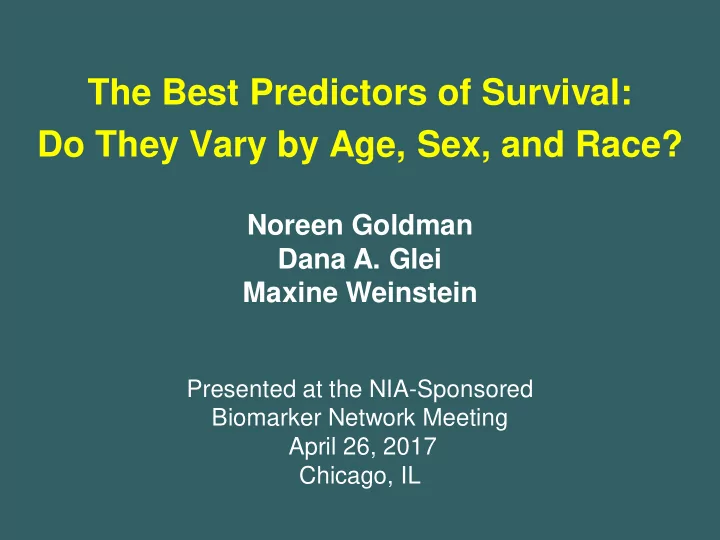

The Best Predictors of Survival: Do They Vary by Age, Sex, and Race? Noreen Goldman Dana A. Glei Maxine Weinstein Presented at the NIA-Sponsored Biomarker Network Meeting April 26, 2017 Chicago, IL
Modern Day Fortune Telling
Introduction • Myriad factors have been linked to human survival: social factors, health conditions, biological markers. • Prognosis: Strongest predictors of survival of older adults are similar across countries with comparable life expectancy. • Do the best predictors of survival differ across demographic subgroups?
Data • 1999-2006 NHANES (U.S.), ages 20+ • Household interview and physical examination • N =18,027 who provided a blood sample & for whom vital status could be verified • Outcome: Mortality < 5 years post-exam • Gompertz hazard model with age as the metric for time (age-specific mortality)
Modeling Strategy • Stratified: – By Age group (20-64, 65-79, 80+)* – Within each age group • By Sex • By Race/ethnicity (non-Latino whites, non- Latino blacks, Latinos)* • 30 predictors, each tested individually • Non-proportional hazards: if age interaction significant for any subgroups, included for all 8 subgroups * Controlling for sex
Predictors of Mortality Demographic Illness-related Biomarkers Age (the “clock”) History of diabetes SBP Sex History of cancer DBP Race/ethnicity History of stroke Resting pulse History of heart disease Total cholesterol (TC) Social factors Hospital stays Marital status HDL cholesterol 5+ medications Education Ratio of TC/HDL Income Overall health/function HbA1c Health behavior SAH BMI Smoking ADL limitations Waist circumference Physical activity IADL limitations CRP Mobility limitations WBC count Serum creatinine (SCr) Homocysteine (Hcy) Serum albumin
Area Under the Receiver Operating Characteristic Curve (AUC) • Objective: assess predictive ability rather than magnitude of the associations • AUC summarizes ability to discriminate between decedents and survivors. • Range: 0.5 = no better than chance and 1.0 = perfect accuracy • Δ AUC>0.01 considered meaningful
Evaluating discrimination with the area under the ROC curve (AUC) Sensitivity: predict death if R died Specificity: predict survival if R survived ___A Strong model ___B Weak model _ _ _ Random coin toss
Top 10 Predictors by Age Group Ages 20-64 Ages 65-79 Ages 80+ SAH .07 IADL Mobility SAH .06 IADL .05 Gain in AUC Mobility ADL ADL Exercise Mobility IADL .04 Income Albumin Smoking 5+ Meds 5+ Meds ADL Albumin Educ .03 Hosp Stays Hosp Stays SAH Smoking Albumin Mar Stat 5+ Meds .02 Heart dis. Hcy Exercise Hosp Stays .01 Social/demographic factors Health behaviors Illness-related Overall health/physical function Biomarkers
Differences by Age Group • SAH and physical function among strongest predictors in all age groups • Importance declines with age: – Social factors (education, income, marital status – Smoking (selective survival?) • Biomarkers: – Albumin is a top predictor in all age groups – Homocysteine emerges among the top 10 only for the oldest age group
Top 10 Predictors by Sex, Ages 20-64 Men Women SAH Albumin .07 SAH .06 IADL Mar Stat .05 5+ Meds Mobility Gain in AUC Income Mobility Income ADL Educ .04 Smoking Educ Hosp Stays Heart Rate IADL .03 Exercise 5+ Meds Smoking .02 .01 Social/demographic factors Health behaviors Illness-related Overall health/physical function Biomarkers
Top 10 Predictors by Sex, Ages 80+ Men Women .07 IADL ADL .06 Mobility IADL .05 Mobility Gain in AUC ADL SAH .04 Hcy Albumin .03 Albumin 5+ Meds SAH Heart dis. SCr .02 5+ Meds Heart dis. Hosp Stays Stroke Exercise Heart Rate .01 Social/demographic factors Health behaviors Illness-related Overall health/physical function Biomarkers
Differences by Race/Ethnicity • Disability measures are weaker predictors for younger blacks • Disease diagnosis: at ages 65-79, heart disease is strongest for whites, cancer for blacks, and stroke for Latinos • Number of hospitalizations ranks particularly high among blacks younger than 80.
How Do Biomarkers Fare? • Serum albumin top predictor in most subgroups – More likely to be a marker of morbidity and survival risk than a causal, modifiable factor • Standard clinical markers (hypertension, cholesterol, and obesity) are generally weak discriminators • More important: Serum creatinine, homocysteine, & CRP (but again, not necessarily causal)
Conclusions • Self-reported health & physical function among the best predictors in all subgroups – More proximate than social/behavioral factors – Integrates an accumulation of biological processes over a lifetime not easily captured in one-time measurement of a biomarker • Although most of the strongest predictors perform well across subgroups, prognostic indexes may need to be optimized for specific demographic groups
Funding This work was supported by: • Eunice Kennedy Shriver National Institute of Child Health and Human Development [P2CHD047879]; and • Graduate School of Arts and Sciences, Georgetown University.
Recommend
More recommend